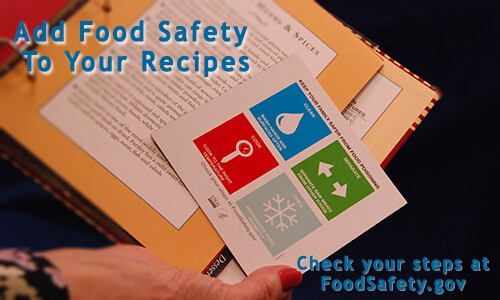
Ahh, Spring! This week, a new season is getting a nice kick-off with Passover and Easter holidays. These celebrations are filled with traditional meals that have unique food safety considerations that may or may not be included in the family recipe book. The USDA Meat and Poultry Hotline has some food safety tips and steps here that, if added to your favorite recipes, can reduce the risk of food poisoning. As with any food preparation, always remember to Clean, Separate, Cook, and Chill.
Before preparing any meal, wash hands with warm water and soap for at least 20 seconds, and clean surfaces and utensils with hot soapy water before and after handling raw food. Perishable food should not be left out for more than two hours at room temperature, so check the time at your gathering and make sure either to get food back in the refrigerator or to discard it. Refrigerated leftovers for all foods in this blog should be used within four days.
Beef Brisket: One reason that it’s an excellent choice for entertaining is that it can be prepared in advance. In fact, you must prepare it in advance and cook it slowly to make it tender. Also, because it can be cooked ahead of time and it reheats well, brisket is a great cut of meat to serve to large groups. Follow these food safety tips for cooking and serving brisket:
- Be sure to allow plenty of time to thaw a frozen brisket. Thawing in the refrigerator can take about 24 hours for a trimmed, first-cut brisket. A whole brisket weighing about 10 pounds can take several days.
- Keep raw meat refrigerated at 40 ˚F or below until ready to cook. Place the meat on a plate or container to hold the juices that can drip on other foods to prevent cross-contamination.
- Bake the brisket, fat side up in a baking dish, in an oven set no lower than 325 ˚F. The brisket is safe to eat when it reaches an internal temperature of 145 °F and is allowed to rest at that temperature for three minutes. Use a food thermometer to be sure. For personal preferences, consumers may choose to cook the brisket longer for tenderness.
- If reheating brisket before serving, remember to reheat to 165 °F.To serve brisket cold, keep it at 40 °F or below by nesting dishes in beds of ice, or use small servings platters and replace them often.
Ham: There are many kinds of hams on the market, but your family likely is purchasing a fully cooked ham. Here are tips for storing and serving a fully cooked ham:
- When buying a ham, look for the USDA or State Mark of Inspection.
- Refrigerate the ham at 40 ˚F or below immediately after arriving home.
- These hams are best served cold. However, if you want to reheat them, set the oven at 325 ˚F and heat to an internal temperature of 140 °F as measured with a food thermometer. If the ham was repackaged at your butcher shop or grocer, reheat it to 165 °F. Individual slices may also be warmed in a skillet or microwave.
Deviled Eggs: Follow these food safety tips below for making an egg dish such as deviled eggs. Remember, eggs are perishable just like raw meat, poultry, and fish, and could contain pathogens.
- Our virtual food safety expert, Ask Karen, has helpful instructions on how to boil eggs.
- After cooking the eggs, it is a good idea to keep the whites refrigerated while preparing the filling.
- Keep deviled eggs chilled until you are ready to serve. Eggs should not stay at room temperature for more than 2 hours. Use a cooler with ice when transporting to another location.
For additional questions visit Ask Karen, our virtual food safety expert available 24/7, at AskKaren.gov or m.AskKaren.gov via smartphone. The Meat and Poultry Hotline can also be reached at 1-888-MPHotline from 10 a.m. to 4 p.m. on weekdays.
